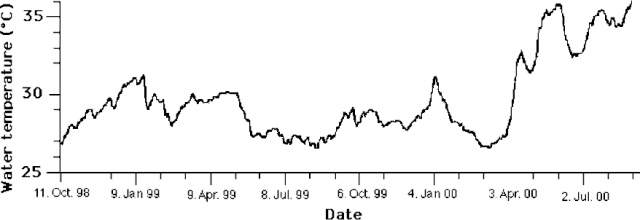Report on Ambae (Vanuatu) — August 2000
Bulletin of the Global Volcanism Network, vol. 25, no. 8 (August 2000)
Managing Editor: Richard Wunderman.
Ambae (Vanuatu) Increase in temperature and acidity at Lake Voui during April-August 2000
Please cite this report as:
Global Volcanism Program, 2000. Report on Ambae (Vanuatu) (Wunderman, R., ed.). Bulletin of the Global Volcanism Network, 25:8. Smithsonian Institution. https://doi.org/10.5479/si.GVP.BGVN200008-257030
Ambae
Vanuatu
15.389°S, 167.835°E; summit elev. 1496 m
All times are local (unless otherwise noted)
Since phreatic eruptions occurred at Voui crater lake in March 1995 (BGVN 20:02 and 20:08) the lake has been closely monitored. No reports of activity were received after October 1998 (BGVN 23:10) until Lake Voui's temperature and acidity increased above normal levels during April through August 2000. Charlie Douglas and Sandrine Wallez reported that in mid-April 2000 the temperature at Lake Voui was ~27°C, but by August it had increased to 35.8 °C (figure 9), which was the highest temperature recorded since they began monitoring the lake in 1998. They also reported that the water's acidity increased. Water analysis conducted on 15 June indicated that the increases were the result of an injection of fumarolic gases into the lake, perhaps related to ascent of new magma.
 |
Figure 9. Water temperature changes in Lake Voui at Aoba during October 1998 to July 2000. Courtesy of Michel Lardy and Michel Halbwachs. |
Geological Summary. The island of Ambae, also known as Aoba, is a massive 2,500 km3 basaltic shield that is the most voluminous volcano of the New Hebrides archipelago. A pronounced NE-SW-trending rift zone with numerous scoria cones gives the 16 x 38 km island an elongated form. A broad pyroclastic cone containing three crater lakes (Manaro Ngoru, Voui, and Manaro Lakua) is located at the summit within the youngest of at least two nested calderas, the largest of which is 6 km in diameter. That large central edifice is also called Manaro Voui or Lombenben volcano. Post-caldera explosive eruptions formed the summit craters about 360 years ago. A tuff cone was constructed within Lake Voui (or Vui) about 60 years later. The latest known flank eruption, about 300 years ago, destroyed the population of the Nduindui area near the western coast.
Information Contacts: Stromboli On-line, maintained by Jürg Alean and Roberto Carniel (URL: http://www.swisseduc.ch/stromboli/); Charlie Douglas and Sandrine Wallez, Geohazard Mitigation Section, Department of Geology, Mines, and Water Resources of Vanuatu (URL: http://www.sidsnet.org/pacific/sopac/members/vu.html); Michel Lardy and Michel Halbwachs, Institut de recherche pour le développement (IRD), P.O. Box 76, Port Vila, Vanuatu.

